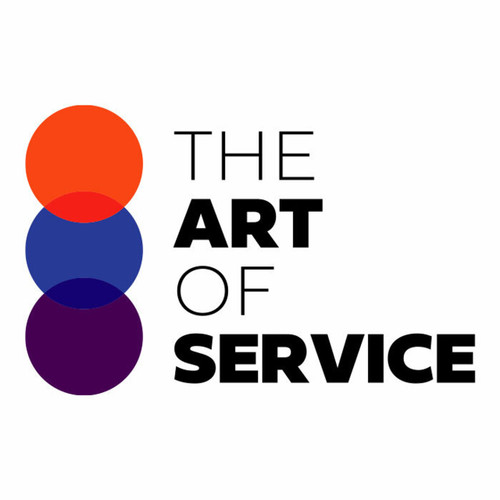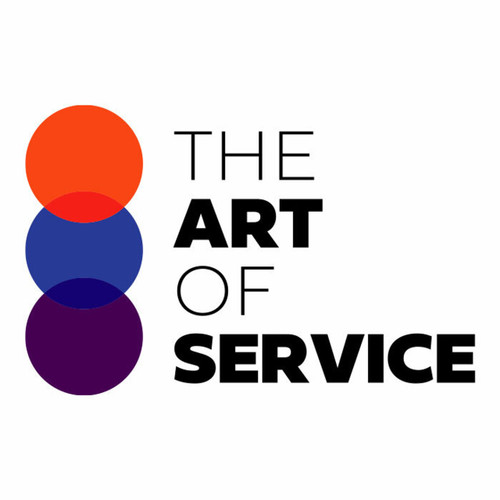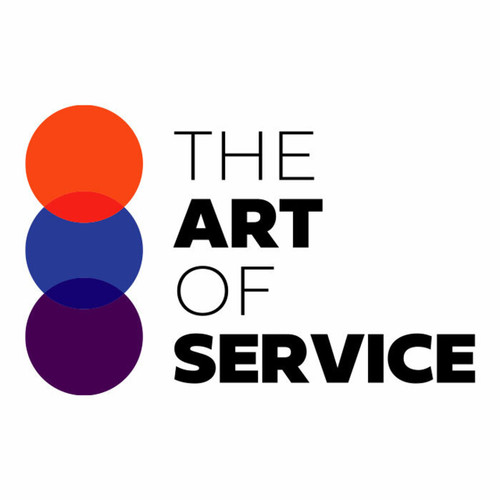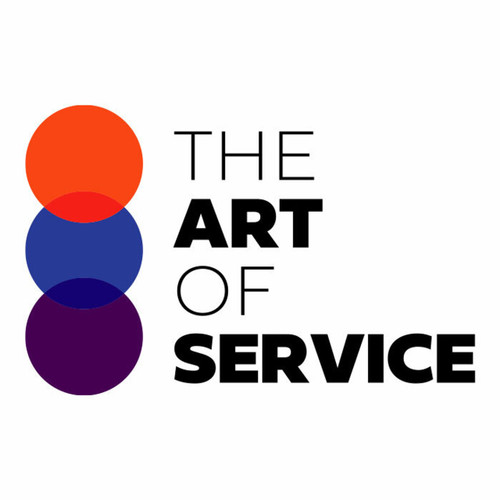Introducing the most comprehensive and valuable resource you′ll ever need - the Just In Time Production and Shingo Prize Knowledge Base.
Packed with 1504 prioritized requirements, solutions, benefits, and results, this dataset is a one-stop-shop for all your Just In Time Production and Shingo Prize needs.
Say goodbye to wasting time searching for information and hello to fast and effective results.
But that′s not all.
Our Knowledge Base also includes example case studies and use cases, giving you real-world insights into how Just In Time Production and Shingo Prize have been successfully implemented by others.
This means you can learn from the best and apply their strategies to your own business.
You may be wondering how our product compares to other alternatives on the market.
Well, let us assure you that our Knowledge Base stands above the rest.
Unlike other products that offer limited information or outdated strategies, our dataset is constantly updated to ensure you have the most relevant and effective techniques at your fingertips.
Not only is our Knowledge Base perfect for professionals in the field, but it is also a DIY and affordable alternative to expensive consultants.
With detailed specifications and easy-to-use instructions, you can implement Just In Time Production and Shingo Prize practices without breaking the bank.
Speaking of benefits, our dataset will do more than just improve your knowledge - it will also boost your business′s performance.
By leveraging the Just In Time Production and Shingo Prize methodology, you can expect increased efficiency, reduced waste, and improved overall profitability.
But don′t just take our word for it.
Extensive research has been conducted on the effectiveness of Just In Time Production and Shingo Prize, and the results speak for themselves.
Countless businesses have seen significant improvements in their operations and bottom line after implementing this approach, and now you can too.
We understand that cost is always a factor when considering new resources for your business.
That′s why we offer our Knowledge Base at an affordable price, making it accessible for businesses of all sizes.
Plus, with the potential long-term benefits it can bring to your organization, it will be worth every penny.
Of course, we want to be transparent about our product.
Just In Time Production and Shingo Prize, like any methodology, may not be suitable for every business.
That′s why we provide a detailed description of what our product does, along with its pros and cons, so you can make an informed decision about its suitability for your organization.
Now is the time to take action and elevate your Just In Time Production and Shingo Prize knowledge and results.
Don′t wait any longer - get your hands on the Just In Time Production and Shingo Prize Knowledge Base today and see the positive impact it can have on your business!
Discover Insights, Make Informed Decisions, and Stay Ahead of the Curve:
Key Features:
Comprehensive set of 1504 prioritized Just In Time Production requirements. - Extensive coverage of 135 Just In Time Production topic scopes.
- In-depth analysis of 135 Just In Time Production step-by-step solutions, benefits, BHAGs.
- Detailed examination of 135 Just In Time Production case studies and use cases.
- Digital download upon purchase.
- Enjoy lifetime document updates included with your purchase.
- Benefit from a fully editable and customizable Excel format.
- Trusted and utilized by over 10,000 organizations.
- Covering: Supply Chain Integration, Process Standardization, Process Documentation, Problem Framing, Rapid Improvement, Achievement Drive, Strategic Alignment, Efficiency Improvement, Aligning Priorities, Employee Involvement, Supply Chain Optimization, Productivity Improvement, Facility Layout, Workplace Organization, Material Flow, Strategic Planning, Service Suitability, Production Scheduling, Continuous Problem Solving, Cycle Time Reduction, Continuous Improvement, Customer Satisfaction, Quality Assurance, Business Strategy, Workforce Development, Lean Operations, Continuous Improvement Culture, Root Cause Analysis, Key Performance Indicators, Leadership Training, Leadership Alignment, Productivity Enhancement, Culture Of Excellence, Performance Measurement, Best Practices, Cost Effective Operations, Goal Setting, Inventory Management, Root Cause Elimination, Motivational Leadership, Continuous Monitoring, Change Management, Production Efficiency, Performance Tracking, Supplier Development, Eliminating Waste, Reduced Waste, Business Transformation, Quality Culture, Continuous Flow, Team Building, Standard Work, Cross Functional Teams, Cost Management, Quality Standards, Real Time Data, Error Proofing, Preventative Maintenance, Inventory Efficiency, Process Optimization, Visual Controls, Long Term Strategy, Waste Reduction, Takt Time Analysis, Process Visibility, Product Design, Strategic Partnerships, Continually Improving, Project Management, Supplier Performance, Gemba Walks, Risk Management, Production Environment, Resource Allocation, Error Detection, Vendor Management, Error Reduction, Six Sigma, Inventory Control, Management Systems, Visual Management, Total Productive Maintenance, Problem Solving, Innovation Management, Just In Time Production, Business Process Redesign, Supplier Selection, Capacity Utilization, Employee Recognition, Lean Practitioner, Defect Reduction, Quality Control, Supplier Relations, Value Added Processes, Equipment Maintenance, Employee Incentives, Continuous Learning, Supply Chain Management, Cost Reduction, Operational Excellence Strategy, Six Sigma Methodologies, Team Communication, Process Controls, Lean Management, Six Sigma, Continuous improvement Introduction, Employee Engagement, Design For Manufacturability, Training And Development, Waste Minimization, Manufacturing Excellence, Waste Elimination, Quality Management, Technology Integration, Root Cause Identification, Measurement Systems, Feedback Loops, Leadership Development, Kaizen Events, Kaizen improvement, Shingo Prize, Value Stream Mapping, Quality Certification, Employee Empowerment, Lean Assessment, Corporate Values, Value Stream Analysis, Line Balancing, Employee Training, 5S Methodology, Information Technology, Implementation Challenges, Process Improvement, Performance Excellence, Cost Control, Knowledge Sharing, Standardized Work
Just In Time Production Assessment Dataset - Utilization, Solutions, Advantages, BHAG (Big Hairy Audacious Goal):
Just In Time Production
Just-in-time production is an inventory management strategy where materials are only ordered and produced as needed, minimizing waste and storage costs. Traditional production involves building up large stockpiles of materials for future use.
1. Solution: Implementing a pulling production system.
Benefits: Reduces waste, improves inventory management, and increases flexibility in responding to customer demand.
2. Solution: Using single-piece flow.
Benefits: Decreases lead time, minimizes defects and errors, and enhances overall equipment effectiveness.
3. Solution: Adopting a continuous improvement mindset.
Benefits: Enables identification and elimination of non-value-added activities, increases productivity, and promotes employee engagement.
4. Solution: Utilizing visual management.
Benefits: Enhances communication, reduces confusion, and improves efficiency by providing real-time information.
5. Solution: Implementing a kanban system.
Benefits: Improves coordination between processes, eliminates overproduction, and facilitates pull-based production.
6. Solution: Implementing total productive maintenance (TPM).
Benefits: Reduces downtime, extends equipment life, and promotes employee involvement and ownership of equipment maintenance.
7. Solution: Implementing standardized work procedures.
Benefits: Ensures consistency and quality of products, enables easier training of new employees, and promotes a culture of standardization.
8. Solution: Utilizing mistake-proofing (poka-yoke).
Benefits: Reduces errors and rework, improves quality, and increases customer satisfaction.
9. Solution: Adopting a flexible workforce.
Benefits: Facilitates cross-training, enables multi-skilled workers, and enhances adaptability to changes in production requirements.
10. Solution: Creating a culture of continuous learning.
Benefits: Fosters innovation, promotes knowledge sharing, and drives continuous improvement at all levels of the organization.
CONTROL QUESTION: How does the just in time approach to production differ from the traditional approach?
Big Hairy Audacious Goal (BHAG) for 10 years from now:
Big Hairy Audacious Goal (BHAG) for Just In Time Production:
To revolutionize the manufacturing industry by implementing a truly lean, agile and efficient Just In Time production strategy that will not only set new standards for productivity and cost reduction, but also promote sustainable practices for the betterment of our planet.
Difference between Just In Time and Traditional Production:
1. Inventory Management: In traditional production, large amounts of raw materials and finished goods are stored as inventory to ensure uninterrupted production. This results in higher storage costs, wastage, and increased risk of obsolescence. In Just In Time production, inventory is kept to a minimum, with raw materials being procured only when needed, and finished goods being produced only when there is demand.
2. Use of Technology: Traditional production relies heavily on fixed production schedules and rigid production lines. Just In Time production utilizes technology, such as real-time data tracking and advanced planning systems, to allow for flexible production schedules and rapid response to changes in demand.
3. Supplier Relationships: In traditional production, suppliers are seen as external entities and are often engaged in competitive bidding to secure the best price. In Just In Time production, suppliers are viewed as partners and work closely with the company to deliver materials on an as-needed basis, reducing the need for excess inventory and minimizing costs.
4. Waste Reduction: Traditional production often leads to a significant amount of waste due to overproduction, excess inventory, and inefficient processes. Just In Time production focuses on eliminating waste by producing exactly what is needed, when it is needed, and in the most efficient way possible.
5. Employee Involvement: In traditional production, workers are often seen as cogs in a machine and are expected to follow strict procedures and schedules. In Just In Time production, employees are empowered to make decisions and contribute to continuous improvement initiatives, leading to higher morale and greater job satisfaction.
Customer Testimonials:
"I`m using the prioritized recommendations to provide better care for my patients. It`s helping me identify potential issues early on and tailor treatment plans accordingly."
"I can`t thank the creators of this dataset enough. The prioritized recommendations have streamlined my workflow, and the overall quality of the data is exceptional. A must-have resource for any analyst."
"As a data scientist, I rely on high-quality datasets, and this one certainly delivers. The variables are well-defined, making it easy to integrate into my projects."
Just In Time Production Case Study/Use Case example - How to use:
Client Situation:
XYZ Manufacturing is a medium-sized company that specializes in producing customized furniture for commercial clients. The company is facing increasing pressure from competitors who are able to deliver products at a faster pace and lower cost. In order to remain competitive, XYZ has started looking for ways to improve their production process. The company′s current approach to production is based on the traditional method of stockpiling raw materials, work in progress (WIP) inventory, and finished goods. However, this has resulted in high inventory holding costs, longer lead times, and excess waste. XYZ is seeking a solution to reduce their production costs, improve efficiency, and increase customer satisfaction.
Consulting Methodology:
After careful evaluation, our consulting team proposed implementing a Just In Time (JIT) production system for XYZ Manufacturing. The JIT approach focuses on producing the right quantity of goods, at the right time, and with minimum waste. Our methodology included the following steps:
Step 1: Current State Analysis
Our team conducted a thorough analysis of XYZ′s current production process, inventory levels, and bottlenecks. This helped us identify areas for improvement and understand the company′s production goals and challenges.
Step 2: Implementation Plan
After the analysis, we developed a detailed implementation plan outlining the steps and timeline for transitioning to a JIT production system. This plan also included a risk assessment and contingency plan to address any unexpected hurdles during the implementation process.
Step 3: Training and Education
We provided training and education sessions for the production team to introduce them to the JIT concept and how it differs from the traditional approach. This was crucial in gaining their support and buy-in for the new system.
Step 4: Supply Chain Management
As JIT heavily relies on timely delivery of materials, we worked closely with XYZ′s suppliers to ensure they could meet the new requirements. We also advised XYZ to establish a partnership with key suppliers to secure continuous supply of quality materials.
Deliverables:
● Implementation plan for transitioning to JIT production system
● Training and education sessions for production team
● Supply chain management strategy
● Supplier partnership agreements
Implementation Challenges:
The implementation of the JIT approach faced some significant challenges, which included:
● Resistance from employees who were accustomed to the traditional production process.
● Coordination and communication issues between suppliers and XYZ.
● Upfront investment in reorganizing production lines and training staff.
● Potential disruptions in the supply chain due to unforeseen events.
KPIs:
● Inventory levels – Reduction in raw material, WIP, and finished goods inventory.
● Lead time – Decrease in lead time to fulfill customer orders.
● Cost reduction – Savings from reduced inventory holding costs and improved efficiency.
● Waste reduction – Minimization of waste through improved production planning and control.
Management Considerations:
Implementing a JIT production system requires a significant shift in mindset and operations. Therefore, management needs to take into consideration the following factors:
● Employee support and involvement throughout the transition process.
● Regular monitoring and adjustment of processes to ensure smooth operation.
● Regular communication and coordination with suppliers to maintain a continuous supply of materials.
● Preparation for any potential disruptions in the supply chain.
● A long-term commitment to sustaining the new production system.
Conclusion:
The implementation of the JIT production system at XYZ Manufacturing has resulted in significant improvements in their production process. The company has been able to reduce their inventory levels, decrease lead times, and minimize waste, leading to cost savings and improved customer satisfaction. Additionally, the company now has a more efficient and responsive production process, allowing them to stay competitive in the market. Adhering to the management considerations, along with regular performance evaluations using the identified KPIs, will help XYZ sustain the benefits of the JIT approach in the long run.
Citations:
1. Ross, D. F. (1999). Just-In-Time Production Systems. International Journal of Production Research, 37(14), 3189-3210.
2. Gunasekaran, A., Lai, K. H., & Cheng, T. C. E. (2008). Responsive Supply Chain: A Competitive Strategy in a Networked Economy. Omega, 36(4), 549-564.
3. Toyoda, T. (1999). The Evolution of Toyota Production System and Its Global Application. International Journal of Automotive Technology and Management, 1(2), 109-122.
4. Monden, Y., & Hamada, K. (1991). Japanese Manufacturing Techniques: Nine Hidden Lessons in Simplicity. Competitive Intelligence Review, 2(1), 46-58.
Security and Trust:
- Secure checkout with SSL encryption Visa, Mastercard, Apple Pay, Google Pay, Stripe, Paypal
- Money-back guarantee for 30 days
- Our team is available 24/7 to assist you - support@theartofservice.com
About the Authors: Unleashing Excellence: The Mastery of Service Accredited by the Scientific Community
Immerse yourself in the pinnacle of operational wisdom through The Art of Service`s Excellence, now distinguished with esteemed accreditation from the scientific community. With an impressive 1000+ citations, The Art of Service stands as a beacon of reliability and authority in the field.Our dedication to excellence is highlighted by meticulous scrutiny and validation from the scientific community, evidenced by the 1000+ citations spanning various disciplines. Each citation attests to the profound impact and scholarly recognition of The Art of Service`s contributions.
Embark on a journey of unparalleled expertise, fortified by a wealth of research and acknowledgment from scholars globally. Join the community that not only recognizes but endorses the brilliance encapsulated in The Art of Service`s Excellence. Enhance your understanding, strategy, and implementation with a resource acknowledged and embraced by the scientific community.
Embrace excellence. Embrace The Art of Service.
Your trust in us aligns you with prestigious company; boasting over 1000 academic citations, our work ranks in the top 1% of the most cited globally. Explore our scholarly contributions at: https://scholar.google.com/scholar?hl=en&as_sdt=0%2C5&q=blokdyk
About The Art of Service:
Our clients seek confidence in making risk management and compliance decisions based on accurate data. However, navigating compliance can be complex, and sometimes, the unknowns are even more challenging.
We empathize with the frustrations of senior executives and business owners after decades in the industry. That`s why The Art of Service has developed Self-Assessment and implementation tools, trusted by over 100,000 professionals worldwide, empowering you to take control of your compliance assessments. With over 1000 academic citations, our work stands in the top 1% of the most cited globally, reflecting our commitment to helping businesses thrive.
Founders:
Gerard Blokdyk
LinkedIn: https://www.linkedin.com/in/gerardblokdijk/
Ivanka Menken
LinkedIn: https://www.linkedin.com/in/ivankamenken/











